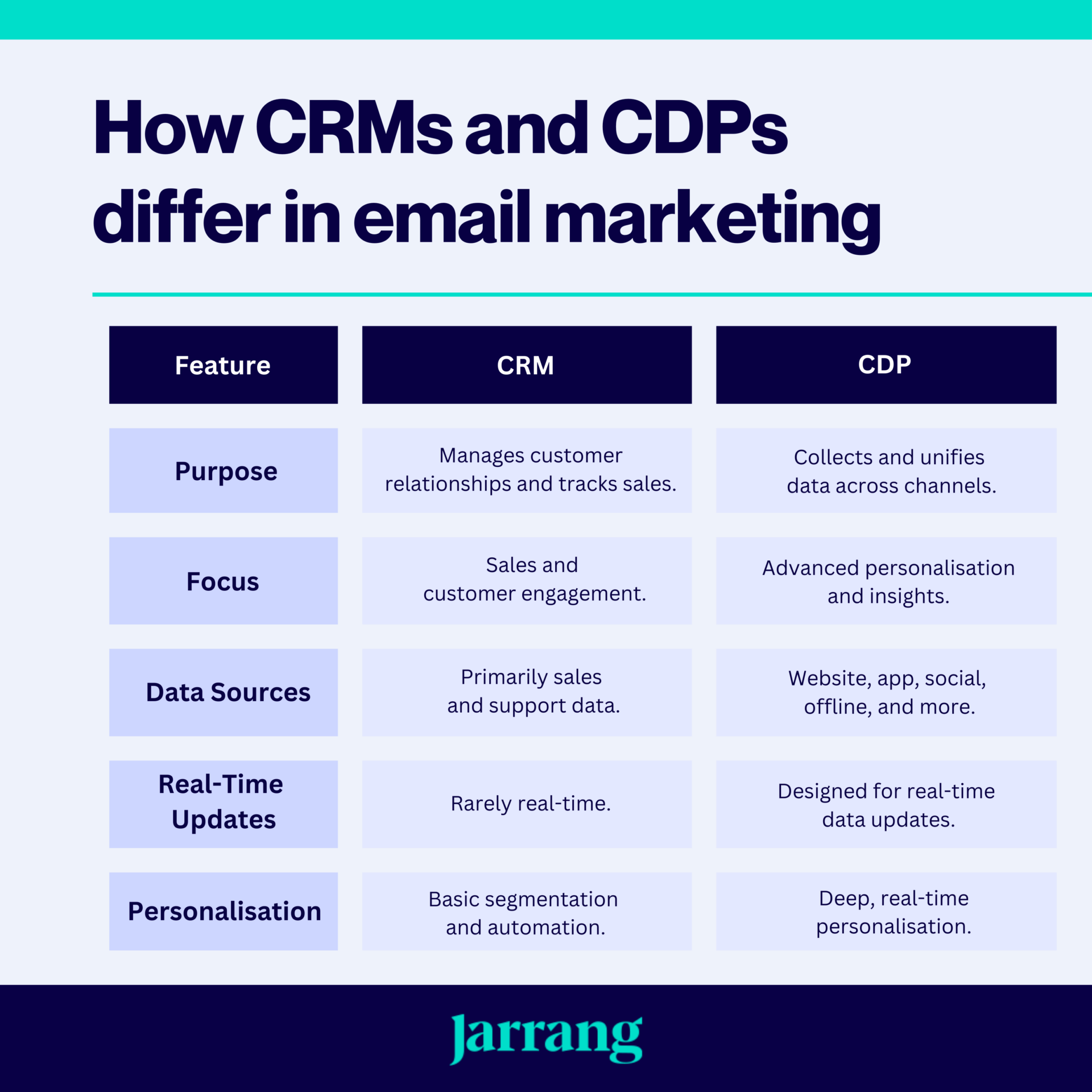The Difference Between a CRM & CDP In Email Marketing
New marketing technology acronyms seem to pop up every time you turn around, and it can be hard to figure out which ones are actually important for your business. Let’s break it down in simple terms and explore how these two platforms can level up your email marketing game

If you’re diving into email marketing, chances are you’ve come across the terms CRM (Customer Relationship Management) and CDP (Customer Data Platform).
At first glance, they might seem like interchangeable tools, but they serve very different purposes. If you’ve ever wondered which one your business needs, or if you need both, you’re not alone.
Getting to know CRMs
A CRM’s main goal is to help companies manage interactions with both existing and potential customers. Think of it as a big digital filing cabinet: You can store contact information, track communication history, and keep tabs on every deal you’ve got in progress.
Most CRMs also allow you to add notes about how a customer responded to an email or phone call, which makes it easy for teams to pass along the right information and keep everyone on the same page. Sales pipelines, lead nurturing, customer support, these are all day-to-day tasks a CRM handles with ease.
But how does that translate to email marketing?
Well, when your marketing team wants to send a campaign to prospects in a particular stage of the sales cycle, a CRM can tell you exactly who those prospects are. It can segment customers by industry, location, or lead score. And if your CRM is integrated with your email marketing platform, you can keep your contact lists updated automatically, which means no more juggling spreadsheets or worrying about stale data.
Where CPDs come into play
A CDP, on the other hand, focuses on collecting customer data from a variety of sources, web analytics, mobile apps, in-store transactions, social media, other marketing tools, then unifying everything into one single, up-to-date profile. Rather than primarily being a tool for the sales or support teams, a CDP is built with marketers in mind. It’s like having a central data warehouse that’s able to store every relevant piece of information about a customer and then feed that information into your various marketing channels, including email.
So why is that valuable? Because with a CDP, you get a far more detailed look at your customers’ behaviour. If someone has opened your last five emails, browsed products on your website, and abandoned their shopping cart, your CDP is recording every one of those actions, often in real time. This data then makes it possible to create hyper-targeted segments. For instance, you could trigger an automated email campaign for cart abandonment that goes out within minutes of someone leaving your site without completing their purchase.
Key Differences
When it comes to email marketing, both CRMs and CDPs can help you understand your audience and send better campaigns. But they do it in very different ways:

If you’re running a sales-driven email strategy like nurturing leads or closing deals, a CRM is your go-to tool. But if you’re managing complex, multi-channel marketing campaigns and want to deliver hyper-personalised content, you’ll need the power of a CDP.
Do you need both?
Here’s the kicker: CRMs and CDPs aren’t competitors, they’re more like teammates. While CRMs help you manage customer interactions, CDPs make those interactions smarter by providing deeper insights.
When used together, they can deliver email campaigns that not only drive engagement but also build stronger relationships with your audience.
Making the right choice
Before you invest in either (or both), it’s worth asking yourself a few questions:
- How many data sources do we have? If you’re only collecting data in one or two places, you might not need the advanced capabilities of a CDP just yet.
- How complex is our email marketing strategy? If you want to send basic campaigns and track open rates, a CRM might be enough. If you’re eager for deeper personalisation and real-time triggers, a CDP will make your life easier.
- How big is our customer base? If you’re dealing with a high volume of customers, a CDP’s ability to handle large amounts of data is more useful.
- Are our teams aligned? A CRM is great for coordinating sales and customer service. A CDP is great for unifying data for marketing. If both teams need a holistic view, then both tools might be the answer.
Whether you’re wrestling with how to best use your current CRM, thinking about implementing a CDP, or simply craving more powerful and personalised email campaign Jarrang can help.
Ready to take your email marketing to the next level?
Our expert team knows how to cut through the jargon and help you maximise the return from your martech stack, no guesswork required. Contact us today to get started!
Subscribe to our insights newsletter
Be the first to know what's trending in email and CRM.
Share this story
Related insights

Article 5 min read
Last-Minute Christmas Email Marketing Ideas for Your Business
Read post
Article 5 min read
